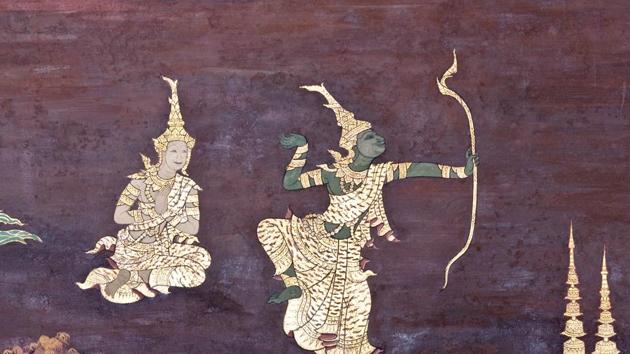Bridging the many interpretations of the Ramayana across Southeast Asia and India
From the Ramakien in Thailand to the Ramaker in Cambodia, the eclectic interpretations of the story in Asean countries are worth recounting
In the 15th century, the capital of Thailand was a city called Ayutthaya, which is Ayodhya in the local language. When Burmese soldiers overran this city in the 18th century, a new king rose. He called himself Rama I, established the city we now known as Bangkok, wrote the epic Ramakien, which is Ramayana in the local language, made it the national epic, and had it painted as murals on the walls of the Temple of the Emerald Buddha, patronised by the royal family. Though he was a Buddhist, the king established his royal credentials by identifying himself with the mythical Ram.

In those days, long before British Orientalists and the colonial divide-and-rule policy, no one distinguished between Buddhism and Hinduism. Ram was as much a hero for Buddhists of Southeast Asia as he was for the Hindus of South Asia. Soon he became a role model for local kings. This legitimising of kingship through Ramayana began more than 1,000 years ago: in a stone inscription from Burma in the Mon language, dated to the 11th century, King Kyanzittha of Bagan dynasty proclaimed that in his previous existence he was a close relative of Rama of Ayodhya.
In the Angkor Wat ruins, built in 12th century Cambodia, in the corridor adjacent to the one depicting the royal procession, one finds carved episodes from Ramaker, the Khmer retelling of the Ramayana. Murals based on the Ramayana are also on the walls of the royal palace complex in Phnom Penh. One story catches our eye. We see Hanuman stretching himself, from the edge of a broken bridge to the shores of Lanka, enabling Ram on his horse-driven chariot and Ram’s grand monkey army to cross the sea effortlessly. This story is not found in the Ramayana that Indians are familiar with. And it vaguely reminds us of the Jataka story in which monkeys escaped the king’s hunters by running across the back of the monkey-king who stretched himself between two trees. We realise this is a unique Southeast Asian twist to the tale, perhaps a Buddhist innovation, or perhaps a Chinese one, inspired by the story of the Monkey-king Sun Wukong who terrorised the Taoist gods, but who was compelled by the Buddha to help a Buddhist monk Xuanzang travel to India and find original Buddhist scriptures.
As in Thailand and Burma, kings of Cambodia today follow Theravada Buddhism. But centuries before, they followed Mahayana Buddhism. And before that they practised Hinduism. These religions originated in India and reached Southeast Asia via Odia and Tamil sea merchants who took advantage of the monsoon winds to make their annual trip there. They exchanged goods and shared stories. It is said that at night, the ship’s cloth sails illuminated by lamps inspired the storytellers to create the art of shadow leather puppet theatre, which explains why shadow puppetry thrived along the Coromandel sea coasts and across most of Southeast Asia, as Ravan-chhaya in Odisha and Wayang in Indonesia, for example.
Direct transmission stopped around 1,000 years ago, around the time that Buddhism waned in India, and sea travel became taboo, with Hindus fearing it would result in loss of caste. Trade was outsourced to Arab sea merchants who also took Islam to Southeast Asia. We can be quite sure of this because the Ramayana found in Southeast Asia lacks the bhakti flavour so integral to the Indian Ramayana, first made explicit in the 9th century Tamil Kamba Ramayana.
Preference for power over piety is evident when one studies the many Southeast Asian depictions of Hanumans. He is more monkey-like and more aggressive, lacking the serene grace given to him in Indian temples. Most disconcerting to the devout Indian Hindu is watching the Southeast Asian Hanuman behaving like a mischievous rake who enchants women, including Ravana’s sister Surpanakha and his wife Mandodari. One of the most common stories told is that of how Hanuman charms and changes the mind of Suvarnamaccha, the mermaid daughter of Ravana, who steals the rocks used by the monkeys to build a bridge to Lanka. In another story, he outwits Vibhishana’s daughter, Benjkaya, a sorceress who takes the form of Sita’s corpse to make Ram turn back.
In the Kakawin Ramayana of Java, while the first part of the story is true to Valmiki’s Ramayana, it is the second which is more popular as it deals with the adventures of the local comic hero, the misshapen guardian god Semar and his three odd sons. The Malaysian Hikayat Seri Rama gives more importance to the decisive Lakshman and is more sympathetic to Ravana while making Ram appear aloof and imperious. These local innovations are further evidence of a long rupture in cultural connection between India and Southeast Asia, one that the current Indian government is determined to rectify.
Devdutt Pattanaik is an author and columnist
The views expressed are personal



